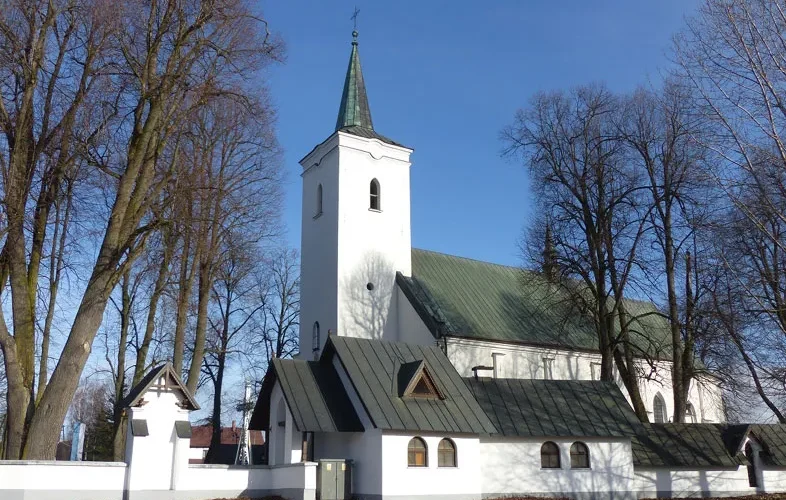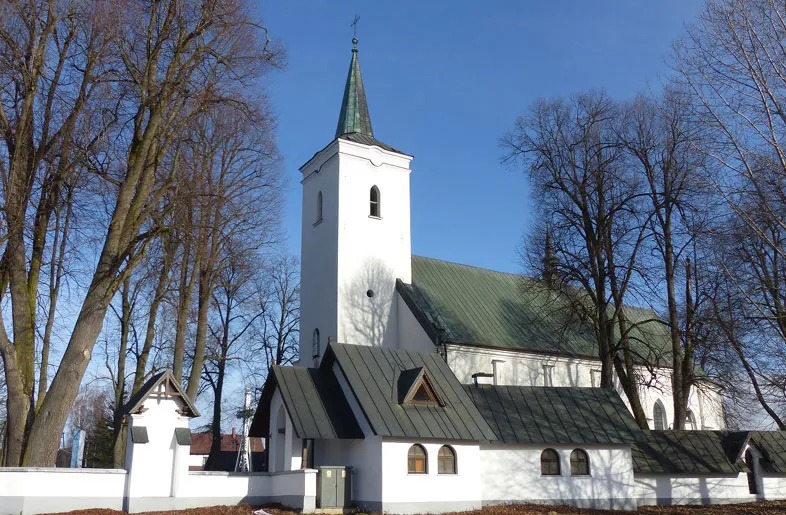
Introduction
The Sanctuary of Our Lady of Ludźmierz in Ludźmierz, Poland is home to Our Lady of Ludźmierz, known as the Shepherdess of Podhale or in Polish Gaździna Podhala. The cult of Our Lady of Ludźmierz is strongly identified with the Góral people who live in the surrounding Tatra Mountains.
One of the key figures for the Marian cult in ludzmierz was Karol Wojtyła, who used to come here to pray on many occasions. The most important church fair is celebrated on 14 and 15 August (the festival of the Assumption of Mary). The figure of God’s Queen Mother of Podhale was donated to the church in Ludźmierz around 1400. Legend has it that the donation came from a merchant who was lost in the nearby moors and decided to call for Mary to help him find his way. He founded the statue out of gratitude for her rescue.
The figure of “Gaździna Podhala” can be found in the altar of the neo-Gothic church built between 1869 and 1877. However, the first wooden temple was erected here soon after 1234, when Ludźmierz became the residence of the Cistercians. Afterwards, however, the monks moved.
In 22 February 2001, the Congregation for Divine Worship and the Sacraments, under the authority of the Holy Father St. John Paul II made the act of giving to the church of Ludźmierz the title of Minor Basilica. In the Archdiocese of Krakow title of have also churches in Krakow, Kalwaria Zebrzydowska and Wadowice.
Bishop’s visitation before the partitions (in 1765.) Says: “In the side altar on the side of the Gospel there is a gilded wooden statue of the Virgin Mary, holding in her hands Baby Jesus”. This figure – according to records of visits – is famous for its centuries countless graces, and draws crowds of pilgrims.
Because of great influence of the faithful in Ludźmierz, the miraculous statue of Our Lady of Ludźmierz is placed on the main altar, with the consent of the authorities of the diocese (1776). Soon great rococo altar was erected for famous statue of Our Lady of Ludźmierz (1795).
It should be added that originally the main altar of the church in Ludźmierz was a statue of the Virgin Mary with Child, artistically beautiful with graces (1420). In the eighteenth century statue of the Madonna was named in the figure of the Immaculate Conception of the Blessed Virgin Mary. The statue is currently on deposit at the museum located in the Collegium Maius in Krakow.
Our Sanctuary also bears the honorable name of “American Ludźmierz.” Ludźmierz is a small mountain town in Poland where the Shrine of Queen of Podhale, dating back to the 13th century, is located.
Inside the Church you can find the miraculous figure of Our Lady of Ludźmierz which St. John Paul II solemnly blessed in Wadowice, Poland on August 14, 1991. He designated it for devotion to the Virgin Mary under this title here at our shrine in Munster.
Since 1991 pilgrims in great numbers, especially Polish Highlanders, have been coming here, inspired by the saintly Pope’s words when he blessed the statue: “May the Queen of the Highlanders be that same Queen for you in America as she is in Poland.” Next to her statue you can see numerous signs of gratitude for graces obtained, among which can be found the rosary of gold and pearls: a special gift from St. John Paul II for our “Heavenly Protector.”
In the spirit of gratitude for the favors received over many years and for the intercession of Mary Bishop Donald Hying from the diocese of Gary celebrated the Solemn Coronation of the statue of Our Lady of Ludźmierz from Munster, on August 21, 2016.
History of Sanctuary of Our Lady of Ludźmierz, Poland
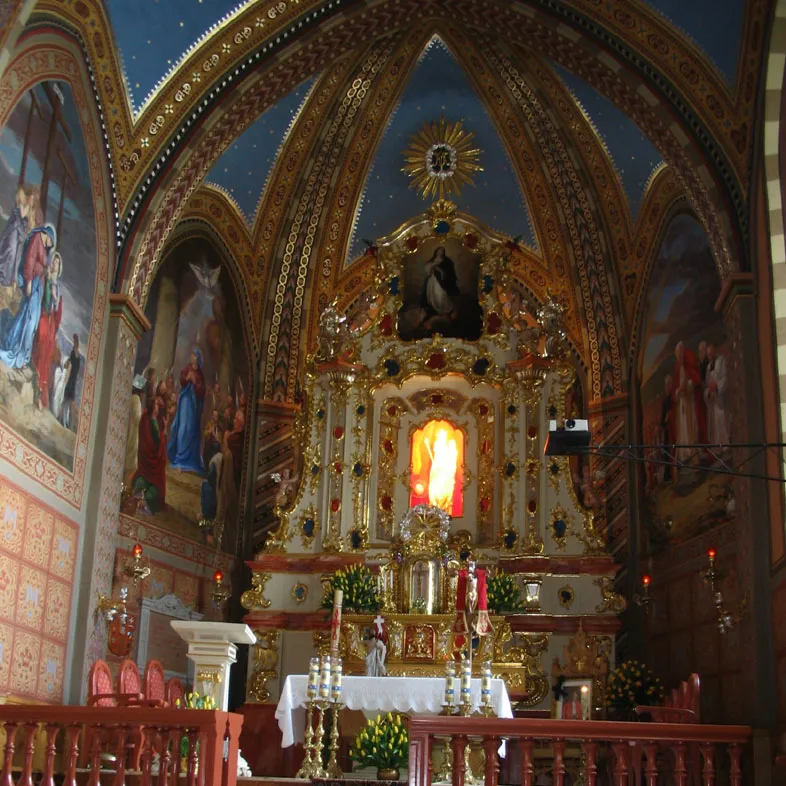
The Marian Sanctuary in Ludźmierz has been the second, after Kalwaria Zebrzydowska, pilgrimage center in the Archdiocese of Krakow for hundreds of years. Ludźmierz is, above all, an image of the piety of Podhale, both individual and collective. Marian devotion is a special manifestation of this.
The Parish of the Assumption of the Blessed Virgin Mary in Ludźmierz is the oldest in Podhale. Wisław, the bishop of Kraków, allowed the voivode of Kraków, Teodor Gryfita, to erect a temple in honor of the Mother of God (1234). It was a time of a district breakdown in Poland. The prince of Kraków and Silesia, Henryk the Bearded, gives Teodor Gryfita the privilege of settling colonists in the forests on the rivers: Ostrowianka, Biały and Czarny Dunajec, Rogoźniki, Lepietnica and in the vicinity of Szczyrzyc.
In the years 1234 – 45 there was a Cistercian monastery in Ludźmierz. The invasion of Tatars and the constant threat from robbers as well as constant floods prompted the order to move the monastery to Szczyrzyc (1245). Nevertheless, the Ludźmierz parish was run by the Cistercians until the 19th century (1824). In turn, the Ludźmierz parish was taken over by the diocese of Tarnów, and then of Kraków (1881).
The existence of the parish church in Ludźmierz in the 15th century is confirmed by historian Jan Długosz. The files of the bishop’s visitation – starting from 1566 – precisely specify:
In Ludźmierz there is a parish church of the Assumption of the Blessed Virgin Mary. The right of patronage is vested in the Cistercian abbot, on whose behalf one of the monks directs the parish, with the consent of the bishop of Krakow. The wooden, larch, shingled church was funded by Teodor Gryfita, the voivode of Kraków. It has three altars. The anniversary of the dedication of the church is celebrated on the Sunday after Easter.
In the years 1869-77 a new, brick, neo-gothic church was built in Ludźmierz – on the site of a demolished larch wood church, which still exists today. The Rococo great altar with its graces, the figure of Our Lady of Ludźmierz, famous for centuries, was moved to it.
It is here, next to the statue of the Virgin Mary, that the religious life of Podhale is focused. And not only, many pilgrims come here from all over Poland, from Slovakia, from Hungary, but also from other countries and not only from Europe. They come to regions stretching at the foot of the granite massif of the Tatra Mountains, often walking along the route of St. John Paul II.
The first preparations for the papal coronation of the figure were started by the parish priest, Fr. Józef Styrylski in 1934, on the occasion of the 700th anniversary of the parish. The outbreak of the war made it impossible to implement the project. His successor, Fr. Leonard Harędziński. Ultimately, the coronation of the miraculous figure took place on August 15, 1963, on the feast of the Assumption of the Blessed Virgin Mary.
It was made by: the Primate of the Millennium, God’s servant, Card. Stefan Wyszyński together with St. John Paul II, then Karol Wojtyła, the bishop of Kraków. During the blessing of the faithful with the crowned figure of Gaździna Podhale, a scepter fell out of her hand, which was grabbed by Bishop Wojtyła during the flight.
This extraordinary episode was commented on by the Primate: Well Karol, the Mother of God gives you the authority.These words took on a new meaning when bishop Wojtyła soon became the metropolitan archbishop, then a cardinal, and finally – the pope, the next successor of St. Peter.
Architecture of Sanctuary of Our Lady of Ludźmierz, Poland
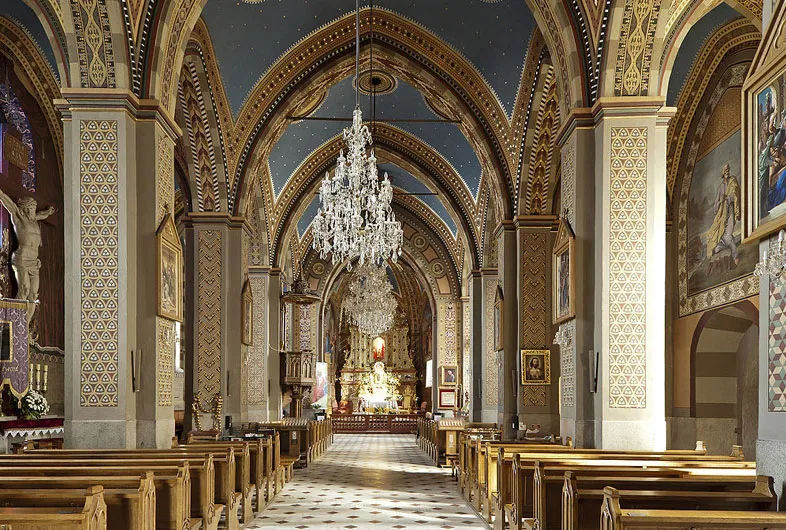
As pope, St. John Paul II “met” Gaździna Podhala twice. During the first pilgrimage to the homeland, on June 8, 1979 at the Nowy Targ airport. And the second time, 18 years later, on June 7, 1997, St. John Paul II came to the Ludźmierz Sanctuary. It was the first Saturday of the month, for the memory of the Immaculate Heart of Mary. The Holy Father presided over the rosary, broadcast by Vatican Radio all over the world.
To commemorate the rosary prayer of the Polish Pope, Podhale people from the USA and Canada, pilgrims, priests and parishioners, at the turn of the millennium of Christianity, and at the same time in the year of the 600th anniversary of the cult of Gździna Podhale, founded the Marian Rosary Garden. 20 highlander chapels, carved by Marek Blajerski, introduce pilgrims to consider the mysteries of the Rosary.
The visit of the Pope, an extraordinary Pilgrim of Ludźmierz, was immortalized in the polychrome in the presbytery of the church and the statue of the kneeling St. John Paul II with a rosary in the center of the Garden. On August 15, 2004, Fr. Card. F. Macharski dedicated the Mysteries of Light in the Rosary Garden.
In the 1980s, a pilgrim’s house was built, cloisters, a garden, a field altar and Stations of the Cross were built. The expansion of the sanctuary is accompanied by concern for the deepening of religious life in Podhale, expressed, for example, through the Fatima services or the peregrination of copies of the statue of Our Lady of Ludźmierz, visiting houses in Podhale, Orawa and Spisz.
It is worth knowing that in the private rooms of the Polish Pope, during the entire pontificate, there was a copy of the statue of Our Lady of Ludźmierz. St. John Paul II from the Ludźmierz Sanctuary refer to many other important events. On May 18, 2001, the Pope elevated the church in Ludźmierz to the rank of a minor basilica and donated his pen.
On April 2, 2009, on the 4th anniversary of the death of St. John Paul II to the Father’s House, a copy of the statue of Our Lady of Ludźmierz was placed in the Milk Grotto in Bethlehem. On August 15, 2011, 3 months after his beatification, Card. Stanisław Dziwisz, Archbishop of Krakow, gave the sanctuary the relics of the Polish Pope.
On August 15, 2017, a chapel dedicated to St. John Paul II with the relics of the greatest pilgrim of Ludźmierz and the texts of the documents issued by the Polish Pope.
Our Lady of Ludźmierz
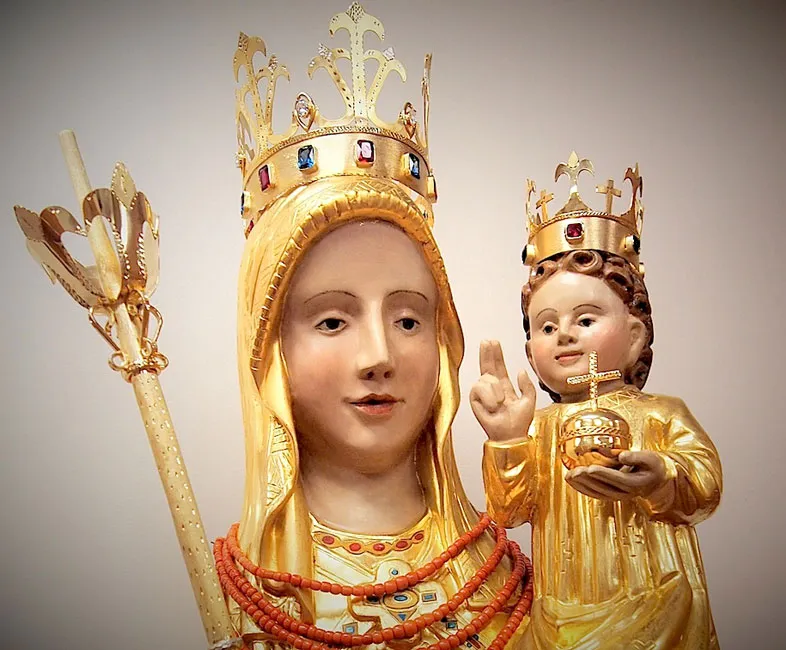
The figurine of Our Lady of Ludźmierz, which has drawn throngs of pilgrims since the Middle Ages was originally placed in one of the church’s side altars, and it wasn’t until 1776 that the statue made its way into the main altar. The statue of Our Lady of Ludźmierz is thought to be about 600 years old. The wooden statue itself is about 125 cm in height, and a replica is situated next to the “miraculous spring” next to the sanctuary.
Multiple copies of the figure have spread all over the world, from the Pfarrkirche of St. Johannes Baptist in Baindt to the church of St. Mary of Częstochowa in Cicero. Most of the spread in devotion to Our Lady of Ludźmierz can be traced back to the outmigration of the Góral community out of their native Carpathian homeland.
The Our Lady of Ludźmierz painting on glass was painted in 1970 by Władysław Walczak-Baniecki (1930–2011), folk artist from Zakopane. It is one of three paintings of his on this theme included in the collections at the Tatra Museum. The other two were completed in 1967 and 1973. They were all painted according to one scheme developed by the artist and repeated in every painting, and they differ only in the colour scheme.
The painting on display is an interesting example of the presence of the Our Lady of Ludźmierz theme in modern paintings on glass from the Podhale region, even at a time when it was not yet flourishing.
The painting differs from other paintings on this theme that were painted according to the later-developed, popular iconographic model where the image of Our Lady of Ludźmierz is frequently supplemented with props associated with the Podhale culture, elements of the highlander outfit, architecture and mountain landscape; and the ornaments feature the edelweiss or carline thistle motifs considered to be typical of the Podhale region.
In his work Władysław Walczak-Baniecki drew only on the traditional method of sacral iconography depicted in paintings on glass, without any regional staffage. In his paintings he freely interpreted the sculpture of Our Lady with a Child from the beginning of the 15th century that could be found in the Church of the Assumption of the Blessed Virgin Mary in Ludźmierz near Nowy Targ.
The history of Ludźmierz, the oldest settlement in the Podhale region, dates back to the 13th century and is directly associated with the settlement of the Cistercian Order. Upon arrival they erected a larch wooden church here and founded the first Catholic parish in the Podhale region.
Folk legend has it that the sculpture of Our Lady was brought to the church in Ludźmierz by a wine-trading merchant. When he was going back to Hungary with his goods, he got lost and fell into a peat bog near Ludźmierz. Saved by a prayer to Our Lady, he vowed to bring her image to the Ludźmierz Church; he kept his promise.
The statue of Our Lady from the Ludźmierz Sanctuary, known since 1963 as the Queen and Hostess of Podhale, has been the object of religious worship for centuries. Inhabitants from the entire region of Tatra (Podhale, Spiš, Orava), Gorce and Beskid Wyspowy Mountains have been and still go on pilgrimages to the miracle-famous figure of Our Lady.
Pilgrims come here most often on 15 August – on the holiday of the church patron, and on the first Sunday of September on the day of the Birth of the Blessed Virgin Mary when highlanders thank the Hostess of Podhale for the harvest. Every year the Podhale Harvest Festival is organised here on this Sunday. Also, every year since the second half of the 1980s, on a Sunday around 23 April, Baca Day is celebrated in the Ludźmierz Sanctuary.
History of Our Lady of Ludźmierz
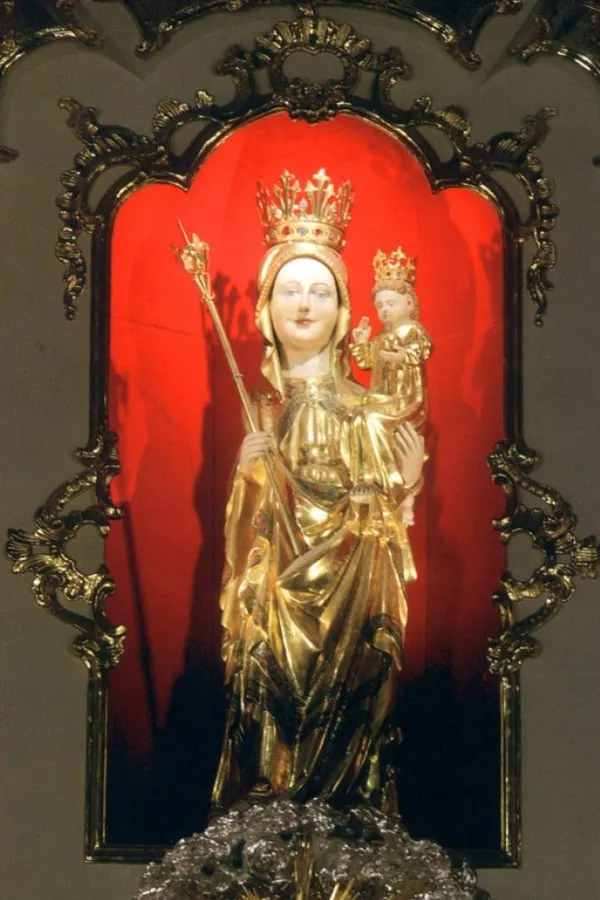
Our Lady of Ludźmierz is primarily the Healer of the Sick. She protects everyone from natural calamities and makes dying easier. She is considered to be the patron and guardian of those lost in journey, and the guardian of highlanders who emigrate in search of work. Although she is visited also by pilgrims from other regions of the country and Slovakia, Our Lady of Ludźmierz is generally considered to be the patron of Podhale.
In his homily on 8 June 1979 in Nowy Targ John Paul II said the following: “Our Lady is always similar to the people from her home. When I was in Mexico, I was looking at Our Lady of Guadalupe, Our Lady of Indians, and I was strongly reminded of Our Lady of Ludźmierz, because she is the true hostess of Podhale. Entire generations of highlanders have been coming to Her and looking for intercession and encouragement, calling for her guardianship”.
The Our Lady of Ludźmierz painting by Władysław Walczak-Baniecki, based on the iconographic model of the miraculous figure from Ludźmierz, depicts the figure of Our Lady holding the Child in her left arm and a decorative sceptre in her right hand. In his left hand the Child is holding a royal orb, the symbol of power held over the world, and is blessing the people with his right hand. There are crowns on the heads of both figures, surrounded by a glorious halo.
Mary is wearing a dress and a mantel covering her back and shoulders; a veil falls down from beneath the crown to her shoulders, while Jesus has a long robe. The top composition is finished with two symmetrical styled rose flowers on leafy branches. Based on the rose motif, the decoration is well-known in nineteenth-century folk paintings on glass and harmonises in its colour scheme, in its careful form with the depiction of Our Lady with Child. Mother of God with Baby Jesus.
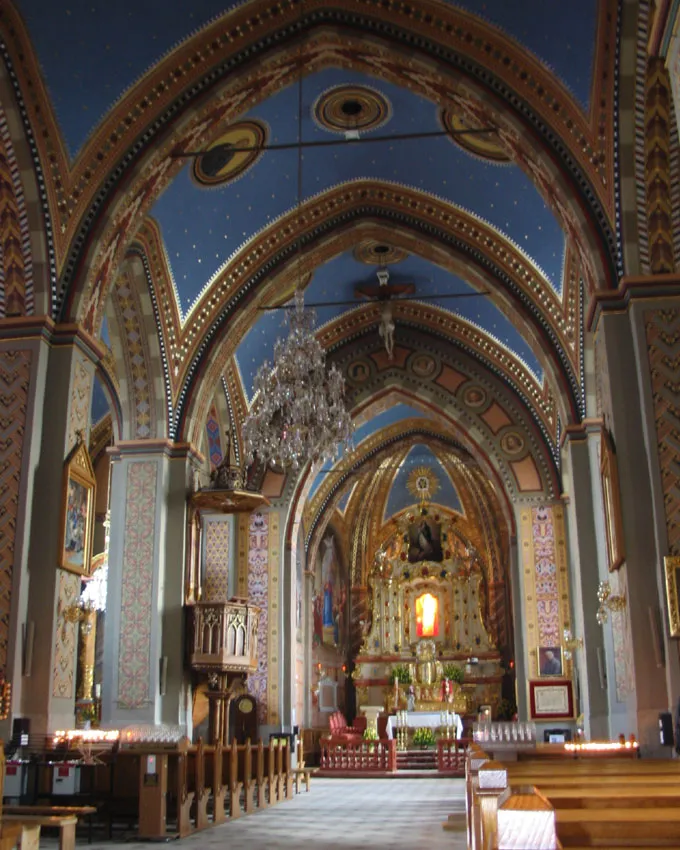
The delicate drawing outline was made with a thin black stroke. The painting uses the colours of the Earth – rusty, natural sienna, whitened English pink and subdued shades of olive and chrome green with touches of gold at the clothing, crowns, halos, orb and flower ornament. The regularly placed dots, dashes and wavy lines depict the clothing folds and perform a decorative function. The background of the painting is black. The painting is signed at the bottom right corner. It is framed in a simple wooden frame, also black.
What attracts one’s attention in Baniecki’s work is the clear and simple composition, simplified drawing, subdued colour scheme and decorative character. By using the image of Our Lady of Ludźmierz from the sculpture, he tried to present Her in a composition layout that was compliant with the original, and his own interpretation of the theme is noticeable primarily in the ornamentation motifs and the colour scheme.
The artists chose the colours of clothing and attributes according to their own painting concept with no reference to the iconographic model. In the painting the large folds of clothing in a shape similar to the letter “V” and the decorative border of mantle tied at the neck that can be seen at the front of the Gothic sculpture of Our Lady of Ludźmierz are interpreted as dress decorations.
The painting on glass technique enjoys particular interest in the Podhale region. It is highly interesting because the painting is painted on the inside of the glass, and the paints are applied to the glass in reserve order in comparison to painting on any other base. First, the figure and ornament outlines are drawn; then the artist paints the details to later fill the larger surfaces marked by the outline with paint and finish for the background. The painters often prepare the image sketches on paper, and they often act as the drawing base for painting on glass.
Władysław Walczak–Baniecki had some problems with drawing, but he was an excellent colourist who constantly enriched the range of colours used in his paintings. “He thought that the background was a field to be managed by painting, and came up with vibrant compositions of gold and a single selected colour. The result turned out to be an artistic revelation” (Aleksander Błachowski, Malarstwo na szkle [Painting on Glass], 2004). He constantly repeated some paintings over the years in a different colour scheme and with new ornamentation motifs.
He had been learning the painting on glass technique by himself since 1962. He made his debut as a painter in 1968 by taking part in the painting on glass competition organised by the Tatra Museum in Zakopane.
He won first place in the folk artist category. Over time he became one of the most valued painters on glass in Podhale. In 2008 he received the Gloria Artis Silver Medal for Merit to Culture granted as a recognition of his merits to folk heritage by the Minister of Culture and National Heritage. The collection at the Tatra Museum houses 111 paintings on glass by Władysław Walczak-Baniecki, which document his artistic oeuvre from the years 1967–2005.
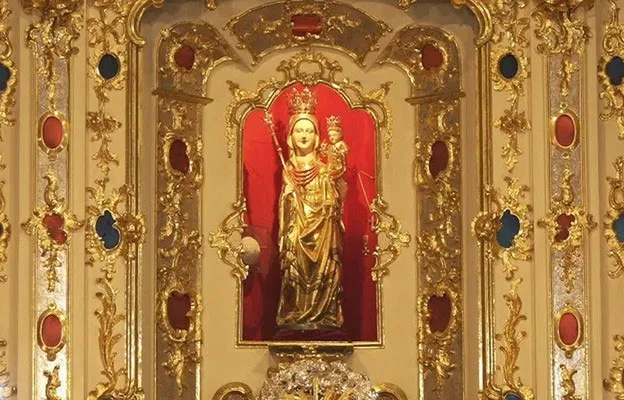
Medieval Legend
There is a medieval legend from about 1400 that refers to the Shepherdess of Podhale or the Gaździna Podhala which refers to a Hungarian merchant on his way to Nowy Targ who after having lost his way in the nearby swamps, was miraculously led out by a mysterious lady to the church.
When he understood that this mysterious figure had been Mary, the mother of Jesus, he attempted to kneel to give thanks in prayer when a miraculous spring burst forth. He pledged to commission a statue that would depict Mary as he’d seen her and bring it back to the church.
Papal prophecy
Perhaps the most well-known story regarding the shrine is an incident during the Canonical Coronation of the statue by Cardinal Stefan Wyszyński on 15 August 1963, attended by the future Pope John Paul II as Bishop of the Archdiocese of Kraków. The statue accidentally slipped during the ceremony and the future pontiff caught the scepter which had fallen out of the statue’s grasp, a scene that was later interpreted as a prophecy of the young bishop’s future selection as Pope.
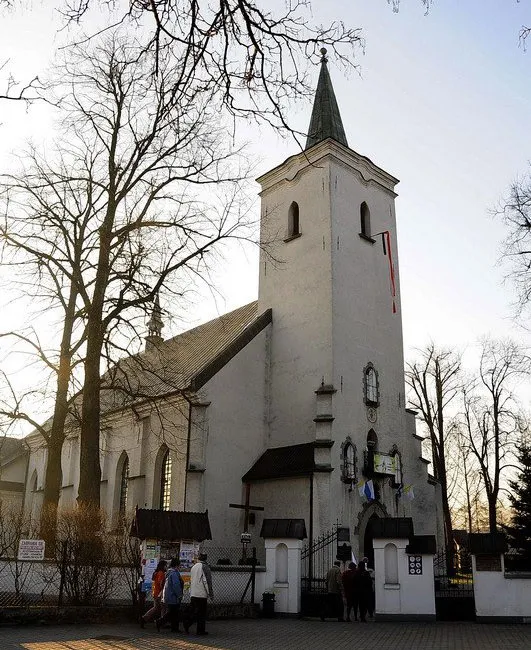
Feast Day - 3rd Sunday of August
We celebrate the Feast of Our Lady of Ludźmierz on the third Sunday of August in the garden every year.
Mass Time
Summer - Weekdays
Sundays
Winter - Weekdays
Sundays
Church Visiting Time
Contact Info
Sanctuary of Our Lady of Ludźmierz,
124, Jana Pawła II,
34-471 Ludźmierz, Poland.
Phone No.
Tel : +48 18 26 555 77
Accommodations
How to reach the Sanctuary
Lądowisko Szpitalne Airport in Nowy Targ, Poland is the nearby Airport to the Sanctuary.
Nowy Targ Transit Station in Nowy Targ, Poland is the nearby Train Station to the Sanctuary.

